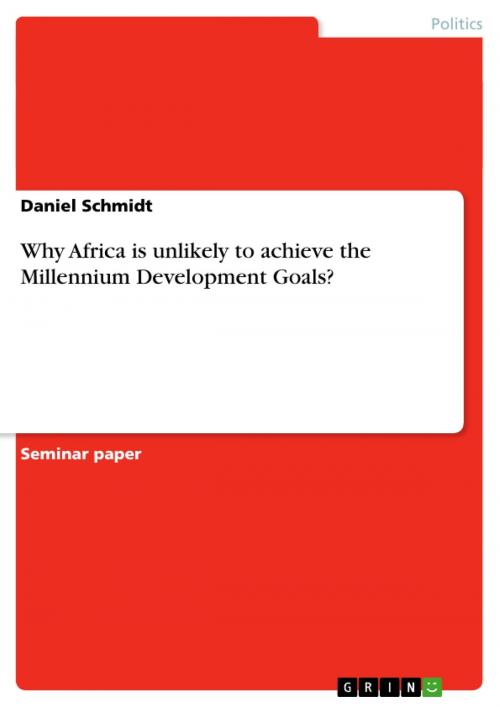Why Africa is unlikely to achieve the Millennium Development Goals?
Nonfiction, Social & Cultural Studies, Political Science, International, International Relations| Author: | Daniel Schmidt | ISBN: | 9783638058742 |
| Publisher: | GRIN Verlag | Publication: | June 5, 2008 |
| Imprint: | GRIN Verlag | Language: | English |
| Author: | Daniel Schmidt |
| ISBN: | 9783638058742 |
| Publisher: | GRIN Verlag |
| Publication: | June 5, 2008 |
| Imprint: | GRIN Verlag |
| Language: | English |
Seminar paper from the year 2008 in the subject Politics - International Politics - Region: Africa, grade: 1,7, University of Tubingen (Politikwissenschaftliches Institut), 50 entries in the bibliography, language: English, abstract: The Millennium Development goals (MDGs) were set in 2000 as an ambitious goal to improve the situation in developing countries in fields such as education, reducing poverty or improving the health situation for the poor. Those goals shall be achieved until the year 2015, which means that halve of the time between the settings of the goals and the supposed reaching of those has passed. Thus it is time to ask how successful the tries have been until now, and if it is still realistic to achieve those goals. This paper will place special emphasis on Africa and especially Sub-Sahara Africa. In this region the smallest progress can be seen, and in certain areas no success as all can be witnessed. The main question, which will be answered in this paper, is therefore: 'What are the problems that prevent the countries in Sub-Sahara Africa to achieve the Millennium Development goals?' In the first section of the paper the Millennium Declaration, which was signed in September 2000, will be introduced, and the growing international acceptation of those goals will be mentioned. (Qureshi, 2004) After that the present situation will be described. When all developing countries are seen together, the data suggest that improvement has taken place and that the implemented strategies have been at least partly successful. But this is a very limited view, as there are different categories of developing countries. The situation in the two biggest countries of the world China and India has improved significantly, and Asia in general has made some progress, especially the regions East and South-East Asia show significant improvement during the last years. The next section will analyse the poor performance of African countries and why this is the case. Two major possible explanations will be given. On the one hand it could be the fault of the giving countries, since they are not investing enough money in Africa. On the other hand not only the giving countries have to be analysed when looking at the failures of the last decade, also the situation in the African countries themselves has to be monitored. The last part of the main paper will look at possible new strategies, which could be used in order to improve the situation in Sub-Sahara Africa.
Seminar paper from the year 2008 in the subject Politics - International Politics - Region: Africa, grade: 1,7, University of Tubingen (Politikwissenschaftliches Institut), 50 entries in the bibliography, language: English, abstract: The Millennium Development goals (MDGs) were set in 2000 as an ambitious goal to improve the situation in developing countries in fields such as education, reducing poverty or improving the health situation for the poor. Those goals shall be achieved until the year 2015, which means that halve of the time between the settings of the goals and the supposed reaching of those has passed. Thus it is time to ask how successful the tries have been until now, and if it is still realistic to achieve those goals. This paper will place special emphasis on Africa and especially Sub-Sahara Africa. In this region the smallest progress can be seen, and in certain areas no success as all can be witnessed. The main question, which will be answered in this paper, is therefore: 'What are the problems that prevent the countries in Sub-Sahara Africa to achieve the Millennium Development goals?' In the first section of the paper the Millennium Declaration, which was signed in September 2000, will be introduced, and the growing international acceptation of those goals will be mentioned. (Qureshi, 2004) After that the present situation will be described. When all developing countries are seen together, the data suggest that improvement has taken place and that the implemented strategies have been at least partly successful. But this is a very limited view, as there are different categories of developing countries. The situation in the two biggest countries of the world China and India has improved significantly, and Asia in general has made some progress, especially the regions East and South-East Asia show significant improvement during the last years. The next section will analyse the poor performance of African countries and why this is the case. Two major possible explanations will be given. On the one hand it could be the fault of the giving countries, since they are not investing enough money in Africa. On the other hand not only the giving countries have to be analysed when looking at the failures of the last decade, also the situation in the African countries themselves has to be monitored. The last part of the main paper will look at possible new strategies, which could be used in order to improve the situation in Sub-Sahara Africa.















